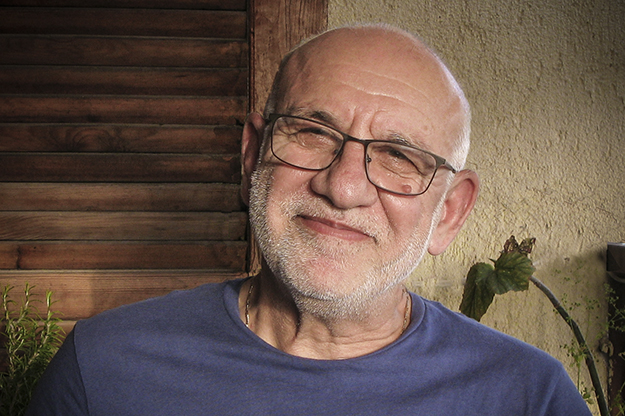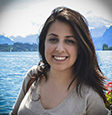Sitting down with Edi Hila in his studio in Tirana, the first thing he makes clear before beginning his interview with K2.0 is that he doesn’t want to talk about his persecution. Hila is frustrated by the fact that the narrative of ‘the persecuted artist’ continues to cloud discussions about his artwork, even today, almost thirty years since the regime’s end.
Rather than using the facts of his denunciation and internment as a means of self-decoration, Hila is not interested in painting himself as a resistance artist, or anything of the like. He instead emphasizes the importance of moving past the ludiocrity that was the art world at the time, and beginning to think about what Albanian art could be, and what it could tell, outside of the context of the regime.
This is difficult, Hila says, when the arts establishment in Albania continues to be dominated by a socialist realist aesthetic, but the unprecedented number of Albanian artists being represented in this year’s documenta 14, one of the most prestigious international art exhibitions in the world, may be a sign that we are heading in a new direction.

Photo: Lorina Hoxha / K2.0.
Hila himself has over 50 works on exhibit at documenta showings in Kassel and Athens. The earliest works are a series of graphite and watercolour drawings that he began in the mid ’70s during his three-year long internment, small pieces that he would keep folded in his notebooks and hidden away. The significance of this period for Hila lies precisely in these small drawings that emerged as physical remnants of an extreme lived experience, rather than the political conditions that led him there.
Hila’s paintings might be seen as a visual testimony to an Albania which seems to be in a permanent state of transition. At the heart of his artistic production is an exploration of the mythologies, psychologies, and failures that such a state has produced.
For Hila, architecture is one of the greatest witnesses and bearers of this history. One of his principal preoccupations throughout his career has been with the Mother Teresa boulevard in Tirana (formerly called the “Martyrs of the Nation” boulevard during the communist era), a boulevard which he holds close as a place that carries his earliest and most beloved memories, but also one which simultaneously bears an ominous political significance, the mystery of which he seeks to uncover.
Hila’s Boulevard series, much like his Penthouse and tent paintings, is characterized by a transformation of everyday built environments into absurdist structures through various manipulations of colour, space, and dimension, exposing their latent qualities. While his previous works have mainly focused on what Tirana’s urbanism says about its identity, his most recent series of paintings for documenta, titled “The Tent on the Roof of a Car,” explores some of the most important phenomena facing Europe today.
K2.0 sat down with Hila to discuss the psychogeography of Tirana, as well as his participation in documenta 14.

Edi Hila’s series depicting the central boulevard in Tirana are just some of his pieces being exhibited at documenta 14. Photo: Michael Nast.
K2.0: Your series of boulevard paintings emerged from your longstanding relationship with the Mother Teresa boulevard in Tirana, that began in your youth. Can you describe some of your interactions with the boulevard and its architecture during that time, and how they have changed as you’ve matured?
Hila: Naturally, when it comes to his own artistry, the artist will ask himself what needs to be made operant through his work — what the message that needs to be transmitted will be, what about it surrounds him in daily life, and how his interruption situates itself within the plethora of problems across his country.
But often we forget that the issues that need to be addressed are very close to us, that even we ourselves are a part of them and there is no need to look for them anywhere, except for within our home, which we know better than anything else.
This is what happened with the boulevard, where we spent our youth, our life. It was there that we met and fell in love. It was in that boulevard that we collided with the politics that produced our history over the years, because it was witness to many events: magnificent military parades, celebrations commanded by the communist dictatorship, and other demonstrations that usually happened in the city center. That boulevard raised the city to the level of a metropolis.
The heavy shadows that the facades of the cold buildings around the center transmit, like those of the Prime Minister’s building, the building for the former Central Committee, the University across from it, as well as others, are associated with a sense of mystery that cloaks every unknown thing. These were the main drivers of how I treated this series of paintings.

Hila’s work has also often focused on the fountain placed on the boulevard during Enver Hoxha’s communist regime, which has since been removed. Photo: Michael Nast.
The fountain that was constructed in Mother Teresa square, which has since been removed, is the subject of several of your paintings. Why was this fountain so significant to you?
The fountain in Mother Teresa square was built during the communist dictatorship and remains in our memory as “the fountain without water.”
If you consider the particular architecture of the square that is now called “Mother Teresa,” it was not easy to interfere with. It was protected by the rationality of the proportions and closely calculated volumes, every interference came into conflict with that aesthetic, and the conceptual necessity of the architecture in its assembly, which was about monumental, imperial grandeur. But the fountain was constructed by the politics of communist propaganda.
This was an unfortunate moment for our urbanism, a violent creative act, but also a political one. After several years, the fountain was taken down, leaving behind a valuable lesson, especially for our urban planning.
In many cases, in my paintings, I distance myself from the fountain’s real existence, displacing it every now and then amidst various buildings, and other times in the middle of the length of the boulevard, in order to give a different rhythm to the composition and to emphasize the surrealistic atmosphere and the creation of imaginary situations.
Why are there no human figures in your paintings?
In order to preserve the aesthetic tendency of the boulevard — which is based on the imperial Roman tradition of fascist architecture and the neoclassical spirit of this architecture — I reduced illustrative representations of events: military parades, popular manifestations, protests, etc.
The rationalist aesthetic is what has mainly served the making of these paintings and oriented their formal conceptualization. On the other hand, I also think that the severity of the shapes, volumes, and spaces in between them better served the tensed atmosphere that has accompanied the years of our relationship — or the relationship of many generations — with this boulevard. I wanted to paint the boulevard precisely from this point of view, rather than as a reproduction of the scenes mounted on it, with the idea that in this way, that which constitutes its essence would be shown more powerfully.

Another of Hila’s series, “Tent on the Roof of a Car” connects with documenta 14’s larger themes around migration. Photo: Mathias Voelzke.
Your most recently completed series, “Tent on the Roof of a Car” is being exhibited in Athens and Kassel as part of documenta 14. Can you speak a bit about this series and how it connects to exhibition’s larger theme, “Learning from Athens”?
The choice I make in the creative field comes as a result of my sincere experiences with the reality in which I live. My participation in documenta came through a creative period in which I was looking for truth in the broadest sense of the word. This is clear not only in the selection of the theme, but also in the decision of what aesthetic position it would take. The idea for “The Tent on the Roof of a Car” emerged very simply: the moment of buying a tent (the kind used for wilderness tourism) and the symbolism of its mounting on top of a car were very provocative and meaningful to me.
Beginning from the close relationship the tent has with architecture, the combination of both of the tent and the car, seen in architectural terms, finds its justification in the Corbusier formula: “the machine for living in.”
The notion of the car as a product of modern times is supported by several points that are closely connected to new aesthetic demands. The car is a synthesis: it is a new spirit, it is reason, it is aesthetics, it is poetry and technique, it is function and construction, it is architecture, and without a doubt, it is history.
The tent on the other hand is nothing but a brief stop and a subsequent dismantlement from one destination to another. It remains a structure that is movable and brittle, where your relationship with it is temporary. The tent is an immediate solution for survival that bears its own mystery. It urges you into escape, into isolation, it guarantees you peace, but at the same time it’s a moving and threatening silhouette.
Of course all of this was situated in the context of the Athens show, in connection to the greater theme, “Learning from Athens.” Athens is one of the main ports that awaits arrival by sea today. Emigration has placed people from two different worlds face-to-face, and they meet exactly at these shores, where the sacrifice of escaping the tragic end of wars is met with the unmatched humanity of unknown territories, who are also now threatened by the same enemy.
My paintings focus precisely on this theme, they attempt to express the complex atmosphere [of today] and to follow as much as possible the dramatic adventure of humanity in modern times. The history of tents is that of a temporary reality: the threshold that needs to be overcome in order to begin a new life. Up until yesterday, tents were the oldest shelter in the world, and today, because of the car, it comes as a proposal, as a new way of life. But since tents come from antiquity in a poetic sense, the new aesthetic cannot be anything but that of the car.
You also have a large number of watercolour drawings that you’re exhibiting at the EMST and Odeion galleries in Athens. Can you speak a bit about these works?
The series of drawings I have exhibited in documenta 14 cover a long period of time, which began in 1970 and lasted until 1990. They mostly belong to the time when I worked in a poultry farm and underwent a “re-education” by the working class, as it was often called at the time.
Being in such close contact with a reality I’d never known before, and which, under the psychological pressure caused by the fact that I was being punished, especially in such a brutal dictatorial regime, my response was very complex and it is expressed amidst these drawings I did throughout those years.

